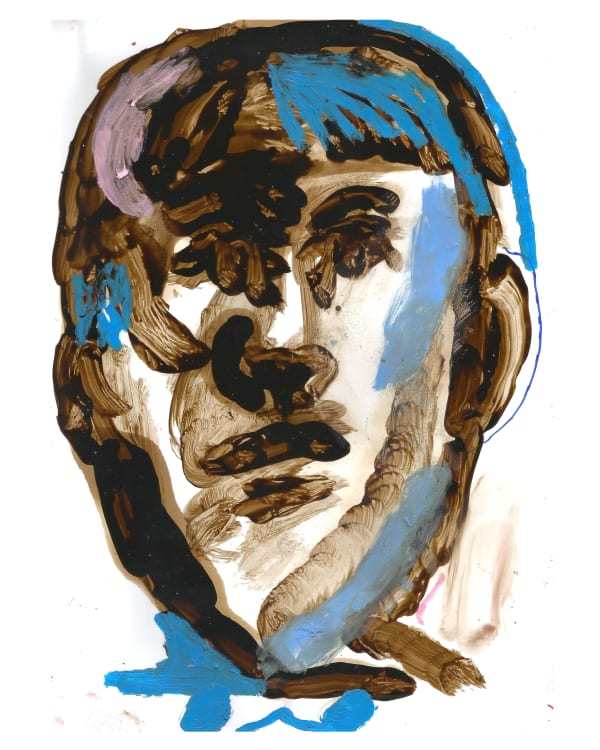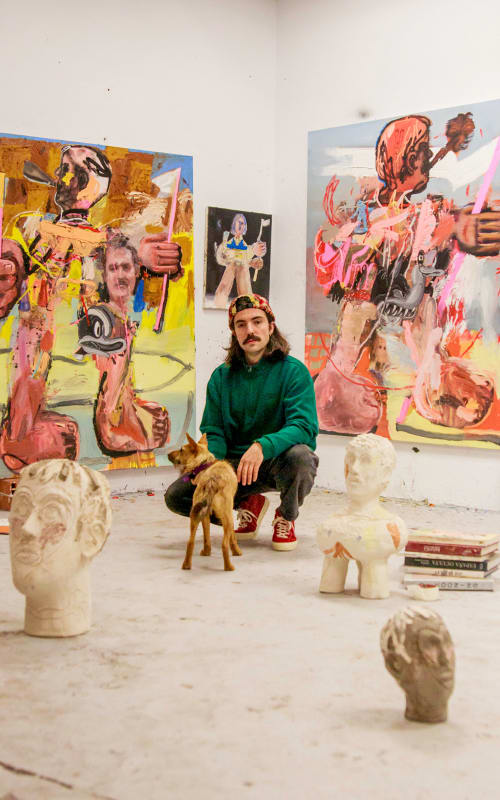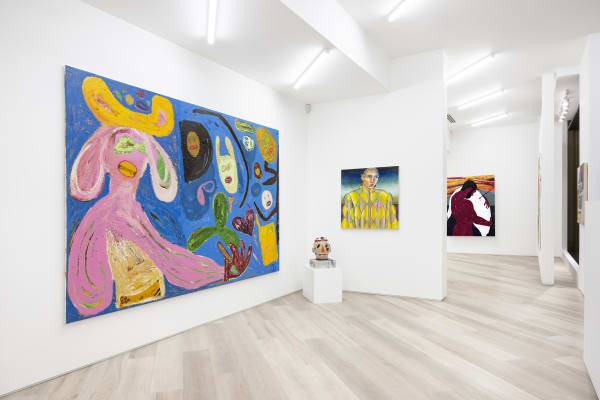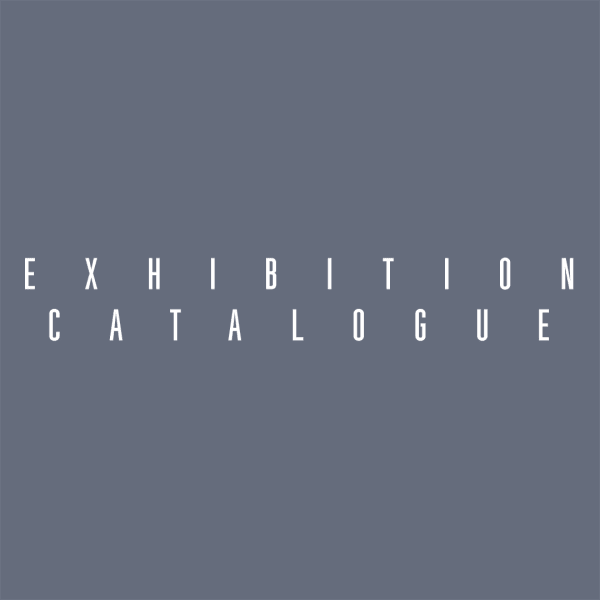MANU GARCÍA
The Spanish painter claims his paintings are something of a diaristic process, and he often draws attention to his tools and materials, or the somewhat ‘random’ objects found around the studio or in his life. Of recurrent interest is a giant pencil, worth of a fever dream, perhaps to draw attention to the most basic tool an artist can utilize to create an image. Throughout his colourful panoply of imagery, García often refers to his own self-reflexive process, and the pencil seems to invite viewers into his thought processes when creating a work.
“The beginning of the works is usually completely abstract… developed in sessions I try to keep as free and random as possible so that I can come up with things that surprise me.” Throughout his works, one sees how his thought processes are further inherent to his creation. Just like Philip Guston, who began painting the detritus and debris around his studio, we see banal elements that have been (carefully?) arranged within the painterly space: kettles, pencils, shoes, Crocs, bits of stitching or various bric-a-brac, or even what appear to be colour swatches tested right upon the canvas surface. There is a pony-tailed woman, whom we interpret as, perhaps, García’s lover or partner. All items appear to be of great familiarity to the artist, almost as a sort of codex for us to decipher in creating a greater mythology surrounding the work. And there is a delicious, visceral freneticism paired with the maturity and confidence to step away from a canvas to allow these visual cues space to breathe, to interact. Comparisons to de Kooning, who worked vigorously and seemingly from a place of pure intention, seem fitting. For García too, this process could be akin to automatic writing: “the work [is conceived] as a game; not in a trivial way, but in the sense of playing with images and spaces to connect with myself and others. Putting together aspects apparently far from logical in a field where primitive impulses and a fragmented aesthetic can share a space.”
García’s work seems concerned with invoking a kind of emotion, but also with creating repeated metaphors and allusions that create a greater narrative. As viewers, we are invited to approach the works with our own stories – stories that we might use to decipher the referents and symbols utilized herein. The infantile scribbles of Red Moon Head speak to childlike wonder; the presence of birds in Like the Bird who Learned to Fly might suggest the dawn of spring, the avian familiars outside García’s studio window, a gesture toward a song, a poem (Emily Dickinson’s “Hope is the Thing with Feathers” springs to mind), or even a popular quote by Martin Luther King, (‘We have learned to fly the air like birds and swim the sea like fish, but we have not learned the simple art of living together as brothers.’) Finally, that recurrent pencil says a lot about the ability an artist like García has in recording his surroundings and presenting them, for eager eyes, to interpret.
MANU GARCÍA (b. 1994, Oviedo, Spain) currently lives and works in Oviedo, Spain. Fernández studied Fine Arts at the University of Salamanca, graduating in 2017. Solo exhibitions include: Dog Bed Games, Marc Bibiloni, Madrid (2025); Bright Light Long Night, HAGD Contemporary, Denmark (2025);Pintura Para Construir En Tu Cabeza, La Bibi Gallery, Mallorca (2024); JUEGO, BEERS London, London (2023); The Cabin LA, Los Angeles (2023); Solo, Galerie Wolfsen, Aalborg, Denmark (2022); I prefer the Sun Except at Night, Borrón Hall, Oviedo, Spain (2021). Prizes include: San Marcos Award, The Salina, Salamanca, Spain (2015; 2016 and; 2017); Bienal de Noreña (first prize), Asturias, Spain (2016); Young Creators La Gaceta, Salamanca, Spain (2014; 2015; 2016 and; 2017); Casimiro Baragaña (exhibition), Pola de Siero, Spain (2017 & 2020); Casimiro Sainz National Painting Contest, Reinosa, Spain (2018) and; 29 Plastic Arts Exhibition of the Principality of Asturias, Asturias, Spain (2018 & 2019). Manu also works with HAGD Contemporary in Aalborg, Denmark.
Group exhibitions include: Have A Good Day, HAGD Contemporary x Morgan Lehman Gallery, New York (2024); 13-A-Dozen, Better Go South, Sttugart, Germany (2024); Temporary Opening of HAGD Contemporary, HAGD Contemporary, Aalborg, Denmark (2023); Watch Me Burn (curated by Rasmus Peter Fischer), Ruttkowski;68, Paris, France (2022); An invisible line, Estudipablodelillo, Oviedo, Asturias, Spain (2020); Corps primaires, Galeria C.O.A, Montreal, Canada (2020); PERSONA, Estudiopablodelillo, Oviedo, Asturias, Spain (2019); Rica Pulpa, Estudiopablodelillo, Oviedo, Asturias, Spain (2018); Cuaderno Moreno, Espacio Naranjo, Madrid (2018); Oasis, Sala LAI, Gijon, Spain (2018); Descodificando Descomisariando, Sala AVAM Matadero, Madrid, Spain (2018) and; Selection best TFG Da2, Salamanca, Spain (2017).
Art Fairs Include: CAN ART IBIZA, La Bibi Gallery (2024); Untitled Miami Beach w. HAGD contemporary (2023).
Residencies include: HAGD Contemporary, Denmark (2025); La Brea Studio Residency – The Cabin LA, LA (2023).
-

FAMILY & FRIENDS
30 Nov - 20 Dec 2023Our final exhibition of 2023 brings together existing and longstanding gallery artists (Hyangmok Baik, Jonni Cheatwood, Deborah Segun) alongside those whose solo exhibitions begin in 2024: including Liam Alvy, Jack Kabangu, Tang Shuo, and Christina Zimpel. Also exhibiting in the group show are a slate of fresh new perspectives, including Peter Larsen, Zoe Spowage, Hannah Wilson and more. The purpose of this exhibition is to introduce new artists into our roster amidst the artists whose practices we have championed for some time. We anticipate an exciting mix to present to our friends, collectors, and followers.Read more -

Manu García: JUEGO
8 Sep - 14 Oct 2023The idea of movement is important to Spanish artist Manuel García, who brings his debut UK solo exhibition, ‘Juego’, to BEERS London this September. Juego is the Spanish word for play. To English-speaking ears, the word suggests something more mysterious than its English counterpart; it sounds somehow seductive and alluring. There’s a buoyancy to the word – not just what it means, but also what it suggests – and there is a similar idea presented within these works.Read more











